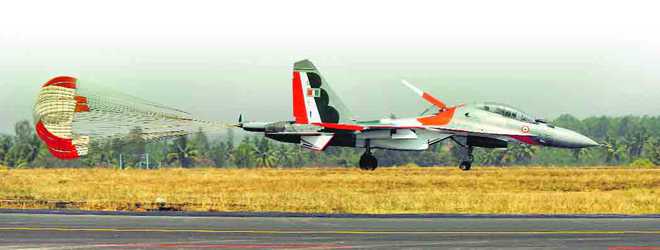
Indian Air Force’s Sukhoi-30 lands at Yelahanka air force station on the outskirts of Bengaluru. The Tribune photo: Vijay Mathur
Dinesh Kumar in Chandigarh
Every year the Indian Air Force (IAF) proudly observes its anniversary on October 8, the day when in 1932 the IAF's predecessor, the auxiliary air force of the Royal Air Force of the British Empire, was raised on a modest note with four vintage Wapiti biplanes (then jocularly pronounced as 'what-a-pity'). Since then the IAF has come a long way in both size and technology considering the phenomenal advances since then in aviation technology and support elements.
The IAF has performed with aplomb in all military operations in India's post-Independence history. Particularly noteworthy have been its performance and role in the 1971 India-Pakistan war when it achieved complete aerial domination of former East Pakistan's airspace and the 1999 high-altitude Kargil war with Pakistan which witnessed incredible innovations. The IAF's transport fleet's continuous silent role of air maintaining troops in extreme and remote corners of the country, whether the high-altitude Ladakh region or the hilly north eastern states bordering China and Myanmar, is a feat that will take several volumes to document.
Import-dependent
The IAF, currently the world's fourth largest, is a completely import-dependent armed force for virtually every weapon platform and weapon system. The IAF's fighter fleet is dangerously depleting -- down to 33 squadrons from the sanctioned 42. At the current rate, the squadron strength is expected to touch a low of 25 by 2022. The current state of the IAF is no better with the Russian-origin Sukhoi-30 squadrons functioning at less than 55 per cent efficiency with almost half of the present fleet unserviceable.
The IAF's fighter fleet comprises fighter aircraft from three different countries -- Russia, France and the UK; a transport fleet from the United States, UK, Brazil, Germany and the former Soviet states of Ukraine and Russia; and helicopters from Russia and France with the US soon expected to provide the Chinook heavy lift and Apache attack helicopters.
Apart from sourcing its fighter fleet from three different countries, the IAF flies seven different types of fighter aircraft thus creating major infrastructure and maintenance issues. The French Rafale, when inducted by 2023, will be yet another addition of an aircraft type in the IAF's inventory for which new infrastructure will be created. The story is similar in the case of the IAF's fixed wing aircraft and helicopter fleet.
Efforts at self-reliance have been agonisingly slow and incomplete. The country's deficiency in self-reliance remains a serious matter of concern for a country that aspires for great power status. The Dhruv advance light helicopter (ALH) has a French engine and a dismal record of accidents. Besides, four of the seven Dhruv helicopters sold to Ecuador have crashed thus adversely affecting its brand image.
The Tejas light combat aircraft (LCA), under development since 1983, has been inducted without a final operational clearance and with 53 waivers and concessions that has severely curtailed its operational capability. A better version (Mark-1A and Mark-II) of the Tejas is still under development and it will be some time before these are inducted.
Depleting strength
The IAF's hope to attain its sanctioned strength of 42 fighter squadrons is well over a decade away indicating how much the air force has slid numerically. It also drives home the fact that both building (and re-building) a technology and capital intensive air force fleet is hugely expensive and involves considerable gestation time.
No country can afford to be cent-percent self-reliant, especially in today's world of globalisation. Even so, all truly great and medium military powers ranging from the US, Russia and China to France and Israel have attained a high degree of indigenous military capability, especially in core and high-end technologies. In contrast, even after several decades India's efforts are still far from fruition.
The IAF has become a critical component not only to fight a war but also as deterrence. Advances in military aviation have increased a country's strike depth while rendering obsolescent the concept of strategic depth. Fighter aircraft with the assistance of flight refuelling aircraft are capable of flying greater distances than before and attacking targets with beyond visual range missiles and precision guided munitions while flight controllers seated in safety thousands of miles away can fire smart bombs with precision from unmanned combat aerial aircraft (UCAV) flying at thousands of feet in the sky. And then, of course, there is always the range and variety of surface-to-surface missiles.
Need to catch up fast
The IAF's future cannot stay hinged on imports. During the Kargil war, India went scurrying for artillery and ammunition. India's traditional ally, Russia, ended up supplying old and defective ammunition at exorbitant prices while South Africa had only refurbished second-hand Howitzers to offer. While Israel was of great support during the Kargil war (as was also the case during the 1971 war even though Tel Aviv and New Delhi did not then have diplomatic relations), the quality of their high-resolution satellite pictures were below mark due to a technical problem.
The IAF and the Defence Research and Development Organisation (DRDO) have embarked on developing an 'advanced medium combat aircraft' (AMCA) while New Delhi and Moscow have agreed to jointly develop a Fifth Generation Fighter Aircraft (FGFA). Both aircraft are well over a decade from development. By then the IAF fleet is expected to have further depleted notwithstanding the induction of two Rafale squadrons and more Sukhoi-30 aircraft. There is no certainty about the Tejas which, again, has an American engine. Like the other two Services, the IAF continues to be in the realm of uncertainty.



























